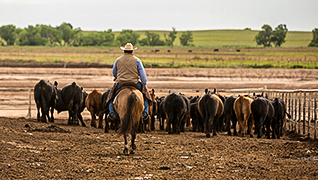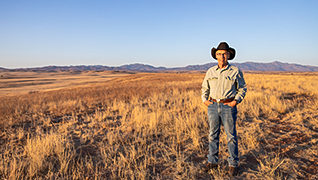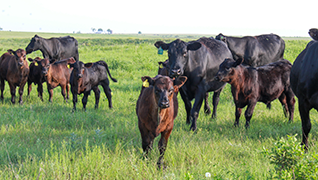

Ross Humphreys’ adept gait tells of many days in and out of the saddle checking his herd, fencelines, water tanks and grass availability. Yet at 72, he can still drop and roll under the barbed-wire fence quicker than most men half his age.
 |
However, Humphreys is not your typical cowboy. He’s a chemist, book publisher, family guy, conservationist and rancher.
He wears many hats, but his black felt wide-brim fits most naturally shading him from the sun at San Rafael Cattle Co., south of Patagonia, Ariz., along the Mexico border. When off the ranch, you can find him in Tucson managing stocks and his publishing company.
Grit in every venture makes him a successful businessman, and his unrattled spirit makes the best of challenges. However, it’s his relentless drive for raising high-quality beef that earned him the 2021 Commercial Commitment to Excellence Award from Certified Angus Beef (CAB).
A different background
Humphreys grew up an “army brat,” traveling and moving most of his childhood. He went to college on the East Coast and earned a degree in chemistry.
After a career as a newspaper photographer, chemist, then a metallurgical engineer climbing smokestacks, he decided to go back to school for a master’s of business administration (MBA). That sent him to New York for a new career in strategic business consulting.
In 1980 he moved to Tucson to manage a newspaper family fortune and later launch a cancer diagnostics company. Along the way, he and his wife, Susan, bought Treasure Chest Books, adding “book publishers” to their résumé.
There was also a short stint when he found a new job study, consulting ranchers with the Malpai Borderlands Group.
In 1999, at 50 years old, never having owned cattle or managed a ranch, he divested from his cancer diagnostics business interest and bought San Rafael Cattle Co. Admittedly, he took an unusual path to the cattle business.
 The ranch is 22,000 acres in the San Rafael Valley with 5 miles stretched against the Mexico border. This photo is taken on his ranch, but the fence and mountains in the background are in Mexico. |
 While Ross Humphreys lives in Tucson, he makes the two-hour drive to the ranch a few times each week. He trusts his cowboys to manage the cattle, repairs and the land day to day. |
“The ranch had been in one family’s name for almost 100 years,” Humphreys says. “I stood on one of the hills with my older daughter and said, ‘Anybody could run a cow on this place, because you can see her wherever she is.’ So that’s how we got started.”
Consistent little changes
Most ranchers learn from their parents or grandparents, but Humphreys went straight to the University of Arizona and bought a Ranching 101 textbook.
He started out doing what many of his neighbors did, raising black baldies and selling calves at weaning. Always curious, his questions led to new acquaintances, and Mark Gardiner of Gardiner Angus Ranch near Ashland, Kan., became his teacher and connector.
“I’ve hardly ever spent any physical time with Gardiners,” Humphreys admits, “but if I called them up, they’d spend two hours on the phone with me answering questions.”
They guided Humphreys, never telling him what to do, but pointing out issues to consider — planting ideas that would turn small changes into significant results.
“When I think of Ross, I think of the book called Moneyball, because he looks at the numbers,” Randall Spare, Kansas veterinarian and another of Humphreys’ mentors, says. “He knew the expected progeny differences (EPDs), and he knew focusing on those numbers would work.”
Humphreys leaned on sound science and good information. It’s what drove him to The Business Breed. No ranch decision is made without running some math and looking at a spreadsheet.
That mindset transformed his herd when profit-driven cattle marketing, like retained ownership, was gaining popularity.
His Hereford-Angus cows quickly shifted after he started buying registered Angus bulls from Gardiner. He focused on selecting for calving ease, docility, ribeye area and marbling to pursue balanced cows that can raise replacement females and a calf crop that produces the best beef.
In 2013 Humphreys attended a lecture in Kansas about genetic profiling. Looking at the other cattlemen in the room whom he had watched buy bulls the last decade, he thought, “I’m definitely not in their club.”
He started profiling all his cows and each set of replacements, and he watched the average genetic profile of his heifers climb. He focused on steady progress built on buying a little better bull than the year before.
Humphreys confirms his plan works with results at the feedyard. Loads of his fed cattle have improved from 20% Prime in 2013 to 95% CAB or higher, including nearly 85% Prime, today.
Emphasis on uniformity makes it easier for his feeding partner to manage his cattle and achieve those results.
 While Susan Humphreys grew up in southern Arizona to a family steeped in ranching, today it is Ross who runs their cattle business. |
Humphreys determined he could be a cattleman who buys cheap and sells cheap, conserving financial resources, or he could sell food.
“I decided that I want to raise beef,” he says. “My goal is to try to produce the best carcass I can. So, I keep trying to nudge up my cow herd so that the calves will be even better the next time.”
Wetter years to come
Environmental investment is key to Humphreys’ long-term goal of sustaining the land as a working ranch.
Collaboration with the Natural Resources Conservation Service (NRCS; see “Preserving today for tomorrow” available as a digital extension to this story by scanning the QR code) helps him set standards and objectives for improving the land and preparing for years when Mother Nature is unkind. The current Southwestern drought continues to challenge his resources.
“After two years of severe drought, the ranch isn’t beautiful anymore,” Humphreys says.
Thoughtful and strategic management of resources is vital in an area that seems to get dryer every year. The 34 square miles of the ranch is split into 25 rotational grazing pastures. He moves the cattle once 40%-50% of the grass is consumed, then returns for regrazing only after it rains.
Even with intensive management, the land still needs water. As a result, Humphreys sold roughly 65% of his cow herd this year.
“It was terrible,” he admits, “except I sold them to two of my best friends.”
Unsure if he will ever get back to predrought herd numbers, he remains committed to this final career as a rancher.
“I want to come home to a beautiful place,” he says. “I started doing this when I was 50, but I like the work. I like the cows.”
Ever the student, he meets each new challenge with a thirst for knowledge, determined to sustain and focused on raising the best, one step at a time.
Editor’s note: Morgan Boecker is the producer communications manager for CAB.

Kansas cattle feeders paved main street for Prime.

Ross Humphreys wins CAB honors in the prime of his life.

Lessen stress, improve calf health for a better start on feed.
Copyright © 2021 · All Rights Reserved · My Website